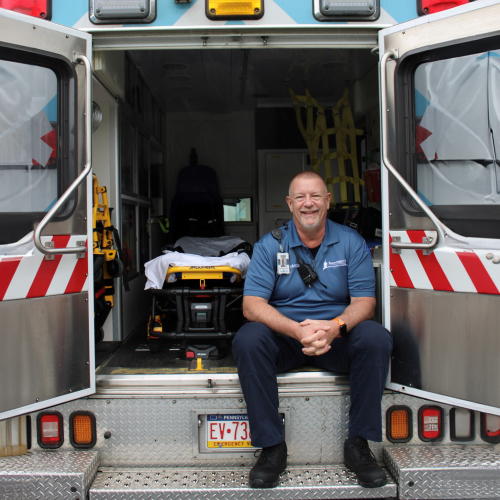
Emergency medical professionals are an integral part of our community, showing up when we need them most. This National EMS Week, celebrated May 19 to 25, Reading Hospital is honored to recognize our dedicated EMS professionals who provide lifesaving emergency medical care each day.
In recognition of the 50th anniversary of EMS Week, we spent a shift with Mike Lerch, EMPT, FTO to learn more about a day in the life of a paramedic.
Lerch, who has been a paramedic for more than 30 years, begins each shift preparing equipment and supplies he might need on a call. Every shift is different because you never know what emergencies may occur, he explained.
“My day starts by getting a report from the previous shift, which usually includes the truck condition, the number of calls that we ran, as well as anything memorable about the shift,” he said. “Next, a check is done on equipment, medication, and general supplies. We also check to see if there are any transports assigned.” Once the equipment is prepared for his 12-hour shift, he works with the team to clean the station thoroughly and complete station chores. He then has free time until an emergency call is dispatched.
“Some of us work on continuing education or cook meals,” he said. “For me, as a Field Training Officer, I have other responsibilities like training new hires in a classroom setting, training them on a shift, and following up with reports and paperwork.” When a call comes through from the Berks County Communication Center, Mike’s crew is prepared, and they jump into action.
As a paramedic, Mike’s responsibility is to provide proper evaluation and administer treatment to the patient on the scene or en route to the emergency department (ED).
Depending on the nature of the call, this includes administering medicine, oxygen, and fluids; monitoring vital signs such as electrocardiograms (EKG); cardiopulmonary resuscitation (CPR); airway management; minimally invasive procedures; and much more. “I have to decide what resources may be required and oversee my fellow crew members,” he said. ”If the patient needs Advanced Life Support (ALS), I become the primary caregiver during transport. If the call requires Basic Life Support (BLS), then the Emergency Medical Technician (EMT) will act as the primary.”
“Whether a patient requires Advanced Life Support or Basic Life Support, we work as a team, he added. “Both crew members are equally important in sharing the responsibility for the treatment of the patient.”
After the patient has been transferred to the receiving facility, the emergency vehicle is brought back to the station to be restocked and cleaned to ensure it’s ready for the next call. “The final piece of the puzzle for the call is the patient care report, which documents the care provided during transport. We end our shifts much the way it began, checking the trucks and giving a hand-off report to the incoming shift, then it’s home for the night to have dinner and relax before getting up and doing it all over again.”
Mike shared that while the job can be tough at times, both physically and emotionally, it’s worth it because he loves to help people. “This is a difficult but rewarding career,” Mike said.
“We see people at their worst, which can leave us scarred. Many of us experience depression and anxiety because of the type of work we do. My recommendation to anyone coming into this field is to use the resources available and to reach out. Be humble and kind as you go through this journey, whether it’s a career or a stepping stone. There is much knowledge and wisdom to learn from us old guys.”
Reading Hospital is proud to offer an Emergency Medical Services program through the Reading Hospital School of Health Sciences. The program’s 6:1 student-to-instructor ratio coupled with its unique combination of classroom, hospital, and field time, ensures that its students are prepared for an exciting career in EMS.
For more information, or to apply online, please visit the Reading Hospital School of Health Sciences or call 484-628-0100.
